天羅地網
標題: The Jin Shin Jyutsu extended sequence for holding fingers [打印本頁]
作者: Rondey 時間: 2019-8-10 12:36
標題: The Jin Shin Jyutsu extended sequence for holding fingers
http://balanceflow.com/the-jin-shin-jyutsu-extended-sequence-for-holding-the-fingers/
In last post (The Jin Shin Jyutsu practice of holding fingers) I talked about two basic ways to practice holding fingers. You can either hold all ten fingers, one after another, first on one hand & then on other, or you can concentrate on attitudes (worry, fear, anger, etc) & benefits (breathing,digestion, fatigue, etc) associated with just one of fingers. I also mentioned that there are two ways to focus on attitudes & benefits of an individual finger: “quickie” & extended sequence. “quickie” is simply to hold one finger. For example, you can hold middle finger when you’re feeling angry or thumb when you’re worried. Jin Shin Jyutsu also provides another way to focus on benefits of individual fingers: extended sequence. This simply involves holding two, 3, or 4 fingers one after other.
Holding fingers — whether you hold all ten fingers or concentrate on one finger — helps bring balance & harmony to attitudes underlying physical & emotional conditions. extended sequence for holding fingers is a way to support & thus harmonize each of basic attitudes associated with individual fingers.
In what follows you’ll find a description of sequence (for example, hold thumb, then middle finger,then little finger) & a brief explanation of why this particular sequence supports attitude associated with finger on which you wish to concentrate.
Remember, acronym for remembering attitude associated with each finger is “Get rid of Worry FAST“: Worry / Fear / Anger / Sadness / Trying To.
The extended sequences & why we use these particular fingers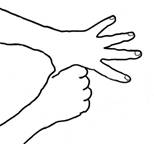 Worry: “quickie” is to hold thumb. extended sequence is to hold thumb, then hold middle finger, then hold little finger.
Worry: “quickie” is to hold thumb. extended sequence is to hold thumb, then hold middle finger, then hold little finger.We hold thumb for Worry. middle finger (Anger) helps deal with frustrations that are often associated with Worry. little finger is associated with Heart ⓕ & helps us take our concerns into heart, where they can be softened.
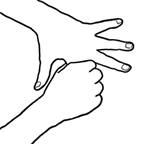 Fear: “quickie” is to hold index finger. extended sequence is to hold thumb, then index finger, then little finger.
Fear: “quickie” is to hold index finger. extended sequence is to hold thumb, then index finger, then little finger.The thumb is associated with Stomach & Spleen energy, which have to do with digestion & grounding. So holding thumb when there is Fear helps bring our energy down (grounding) & gives us energy (digestion). We hold indexfinger for Fear. Holding little finger, associated with Heart energy, supports & energizes process of dealing with Fear.
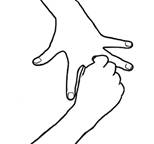 Anger: “quickie” is to hold middle finger. extended sequence is to hold little finger, then ring finger, then middle finger.
Anger: “quickie” is to hold middle finger. extended sequence is to hold little finger, then ring finger, then middle finger.Holding little finger when we are angry alleviates heat of anger (the Fire element is associated with Heart). Holding ring finger, which is associated with Lung energy, helps us breathe. We hold middle finger for Anger.
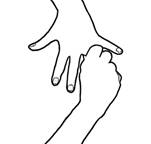 Sadness/Grief: “quickie” is to hold ring finger. extended sequence is to hold thumb, then index finger, then middle finger, & then ring finger.
Sadness/Grief: “quickie” is to hold ring finger. extended sequence is to hold thumb, then index finger, then middle finger, & then ring finger.Holding thumb helps us with Worry that is often involved in Grief. Holding index finger helps us deal with our fears, which can deplete our reserves. By overcoming our fears, we are able to face our grief. Holding middle finger helps us release feelings of frustration, anger, & oppression that may be associated with Grief. We hold ring finger for Sadness.
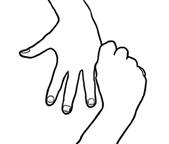 Trying To/Pretense (cover-up): “quickie” is to hold little finger. extended sequence is hold little finger, then ring finger.
Trying To/Pretense (cover-up): “quickie” is to hold little finger. extended sequence is hold little finger, then ring finger.Holding little finger puts us in touch with our Heart energy. Holding ringfinger helps us deal with grief that may be underneath our tendency to put up a defensive front when we are feeling sad on inside. Remember “Trying To” refers to “crying on inside while laughing on outside.”
How to remember extended sequencesIf you’d like to do just one of extended sequences, you can probably manage to remember which fingers to hold. But holding all 5 extended sequences on both hands is also an excellent practice. That may seem like a lot to remember at first.
It’s easy to remember how to hold all ten fingers, first on one hand & then on other. Remembering extended sequences & (coming up in next post) Jin Shin Jyutsu finger mudras requires a bit more effort. But not as much as you might expect.
Think of holding a sequence of fingers as learning a sequence of dance steps. Ultimately you want this to be a kinesthetic (bodily) activity, not a mental one. You remember kinesthetic activities — such as dancing, swimming, & riding a bicycle — with a different part of brain than you use for names & phone numbers. This may surprise you, but people who have memory loss due to Alzheimer’s disease can still remember how to dance.
Here are a few things about extended sequences that you may find helpful when you first try to remember them.
- Each sequence includes finger that is focus of sequence (thumb, index finger, etc).
- Each sequence starts at one side of hand (with thumb or little finger) & moves across hand,holding two, 3, or 4 fingers.
- The first 3 sequences involve holding 3 fingers. fourth one holds 4, & last one holds two.
- For thumb, you hold every other finger.
- For index finger, you start with thumb, then hold index finger (obviously), then move to little finger.
- For middle finger, you start with little finger & hold each finger until you reach middle finger.
- For ring finger, you start at thumb & hold each finger until you reach ring finger.
- For little finger, you hold little finger & then one more, one right next to it, ring finger.
How to practice extended sequencesYou can either hold one extended sequence (for one finger) on one hand (you can also hold it on both hands) or you can hold all 5 sequences on one hand or on both hands. When holding all 5 sequences on both hands, I like to alternate between two hands. That is, I do sequence for Worry (the thumb)on right hand, & then I do it on left hand. Then I do sequence for Fear (index finger) on right hand & then on left. & so on.
In an upcoming post I’m going to recommend combining 3 practices of holding fingers, holding extended sequences, & holding finger mudras into one long session (it takes about half an hour). This is an excellent practice to use while falling asleep or while lying on a firm surface doing constructive rest (also an upcoming post).
This may seem, initially, like a lot to remember, but once you incorporate these sequences into your bodily memory, I think you’ll find your ability to practice all 3 sequences a very satisfying accomplishment. It’s like learning to waltz — a little awkward at first, perhaps, but with practice it becomes second nature, allowing you to relax & focus on breath.
作者: momolove 時間: 2022-10-5 16:33
本帖最後由 momolove 於 2022-10-31 18:14 編輯
感謝分享
現時所有新安裝的氣體熱水爐均必須是密封(對衡)石油氣熱水爐式熱水爐,亦是唯一的選擇
| 歡迎光臨 天羅地網 (http://farflunginfo.com/) |
Powered by Discuz! X2.5 |
 Worry: “quickie” is to hold thumb. extended sequence is to hold thumb, then hold middle finger, then hold little finger.
Worry: “quickie” is to hold thumb. extended sequence is to hold thumb, then hold middle finger, then hold little finger. Worry: “quickie” is to hold thumb. extended sequence is to hold thumb, then hold middle finger, then hold little finger.
Worry: “quickie” is to hold thumb. extended sequence is to hold thumb, then hold middle finger, then hold little finger. Fear: “quickie” is to hold index finger. extended sequence is to hold thumb, then index finger, then little finger.
Fear: “quickie” is to hold index finger. extended sequence is to hold thumb, then index finger, then little finger. Anger: “quickie” is to hold middle finger. extended sequence is to hold little finger, then ring finger, then middle finger.
Anger: “quickie” is to hold middle finger. extended sequence is to hold little finger, then ring finger, then middle finger. Sadness/Grief: “quickie” is to hold ring finger. extended sequence is to hold thumb, then index finger, then middle finger, & then ring finger.
Sadness/Grief: “quickie” is to hold ring finger. extended sequence is to hold thumb, then index finger, then middle finger, & then ring finger. Trying To/Pretense (cover-up): “quickie” is to hold little finger. extended sequence is hold little finger, then ring finger.
Trying To/Pretense (cover-up): “quickie” is to hold little finger. extended sequence is hold little finger, then ring finger.